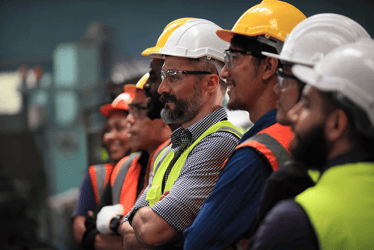The Packaging Industry's Sustainability Challenge: Why ERP Systems Are Essential for Success A straightforward guide to navigating sustainability regulations across folding carton, flexible...
What Process Control Actually Means on the Corrugator
Everyone in the corrugated manufacturing industry talks about "best practices."
It’s a buzzword in production meetings, operator handovers, and continuous improvement plans. But ask five different team members what it means, and you’ll likely get five different answers.
Here’s the truth:
Best practice is not what works for you — it’s what works for the plant, every shift, every run.
In an industry where raw materials are volatile, downtime is expensive, and customer expectations are sky-high, process control isn’t a nice-to-have. It’s essential. And it only works when best practice is clearly defined, measured, shared, and applied consistently.
It’s Not Personal Preference
One of the biggest blockers to improvement is variation between shifts.
- Shift A runs a higher glue gap to avoid delamination.
- Shift B drops the wrap arm tension to prevent warp.
- Shift C resets temperature profiles based on gut feel.
Each operator may believe they’re doing what’s best, but the result is instability. What worked yesterday might not work today. And process tweaks based on preference, not data, create a moving target for quality, waste, and speed.
Best practice isn’t what’s comfortable. It’s what’s proven.
That means:
- Decisions aren’t based on who’s on shift.
- Run settings are predictable and consistent.
- Results are measurable and repeatable.
Standardisation doesn’t mean stripping away all operator input. It means creating a shared foundation, so the team can build on what works and troubleshoot from a common reference point.
It’s Repeatable Performance
Anyone can get lucky and produce great board on one shift.
Best practice is about doing something repeatedly, under various conditions.
Repeatability is the mark of control. It means you can:
- Run to the same quality across multiple shifts
- Hold board specs steady despite seasonal humidity swings
- Maintain throughput across different paper combinations or suppliers
And that doesn’t happen by accident.
To achieve it, you need:
-
Clearly Defined Process Recipes
Setpoints should be documented and dynamically updated as conditions change. Recipes should be based on known paper parameters (grammage, moisture content, heat absorption), not operator memory.
-
Closed-Loop Feedback Mechanisms
Great process control systems don’t just set temperatures or glue rates — they monitor and adjust them.
- If the glue temperature drops due to a lag in starch feed, the system adjusts accordingly.
- If preheater wrap contact decreases, the alerts guide recovery.
This feedback ensures consistent output, even as inputs vary.
-
Training and Enforcement
The best SOPs in the world mean nothing if people don’t follow them.
Train operators not only what to do, but why it matters. Then track conformance.
Where deviation happens, investigate — don’t blame. Use data to reinforce good habits and course-correct gently.
It’s Data-Driven
Best practice without data is just another opinion.
Want to prove your board quality is holding? You need test results.
Want to know if a process tweak worked? Examine the waste and downtime statistics.
Want to validate that a system alert prevented delamination? Check glue metrics and line speed.
Here are the types of data that matter:
- Board Quality Metrics: ECT (Edge Crush Test), FCT (Flat Crush Test), water resistance, warp measurements
- Machine Performance: Run speeds, stops per shift, start-up time, changeover duration
- Glue Consumption: Measured per linear metre — a key cost and quality driver
- Temperature Profiles: Stability across liners and flutes, and recovery time after stoppages
- Starch Performance: Usage, viscosity variation, application accuracy
This data should flow directly from the control system into dashboards that operators, supervisors, and engineers can all access. That’s how you move from intuition to insight.
Bonus tip: Don’t just track KPIs — visualise trends. A 5% drop in temperature stability might not trigger alarms, but it could be a leading indicator of bigger issues on the horizon.
It’s Shared Knowledge
Too many plants still rely on “walking knowledge” — the know-how that lives in one operator’s head and nowhere else. The risk? When that operator retires or leaves, so does your plant's most valuable intellectual property.
If you want best practice to drive plant-wide performance, it must be:
- Accessible: Clear SOPs, training guides, and run histories available at the machine, not hidden in SharePoint folders.
- Repeatable: Recipes and setpoints that can be recalled and reused with confidence.
- Understood: Operators must know the why, not just the what.
One powerful tactic? Create a super user network. These are frontline team members who have been trained more deeply on the system, empowered to support others, and tasked with maintaining adherence to best practices across shifts.
Also, update documentation continuously. Don’t treat SOPs like museum pieces. If conditions change, suppliers evolve, or system logic improves, bake those learnings back into your processes.
That’s how best practice becomes a living system, not a static policy.
What Best Practice Looks Like
Let’s make this real. Here's what best practice process control might look like on a corrugator running single wall C flute with two different linerboard sources:
Paper Recipe:- Source A: Medium gram, mid-moisture, neutral pH
- Source B: Higher porosity, more moisture variability
- Preheater wrap for Source B increased by 8° to offset the higher water content
- Glue gap adjusted by 0.15 mm for Source B to maintain bond strength
- Speed capped at 10 m/min lower to prevent warp under colder ambient temperatures
- Steam pressure held within ±2 PSI using closed-loop control
- Bond integrity checked every 30 minutes via manual inspection — results logged digitally
- Digital checklist signed off at the start of each shift
- Alerts prompt action if the glue temperature varies by more than 3°C
- Monthly sessions on interpreting system feedback and understanding recipe logic
- Operators shadow super users during fault scenarios to build troubleshooting fluency.
This approach doesn’t just produce good board — it produces predictable, scalable outcomes.
True Process Control Begins Where Opinion Ends
When everyone has their way of doing things, there is no control — only chaos.
Process control starts when you stop guessing and start measuring.
That’s what best practice is about:
- Creating consistency
- Reducing variation
- Delivering predictable performance
- Building a plant that learns, improves, and sustains results — shift after shift
Ready to Go Deeper?
Whether you're looking to reduce waste, increase uptime, or empower your operators, the first step is understanding your process.
- Join one of our live or on-demand webinars to explore best practices in real-world scenarios.
- Or book a corrugator consultation - we’ll review your current setup and highlight key areas for improvement.




